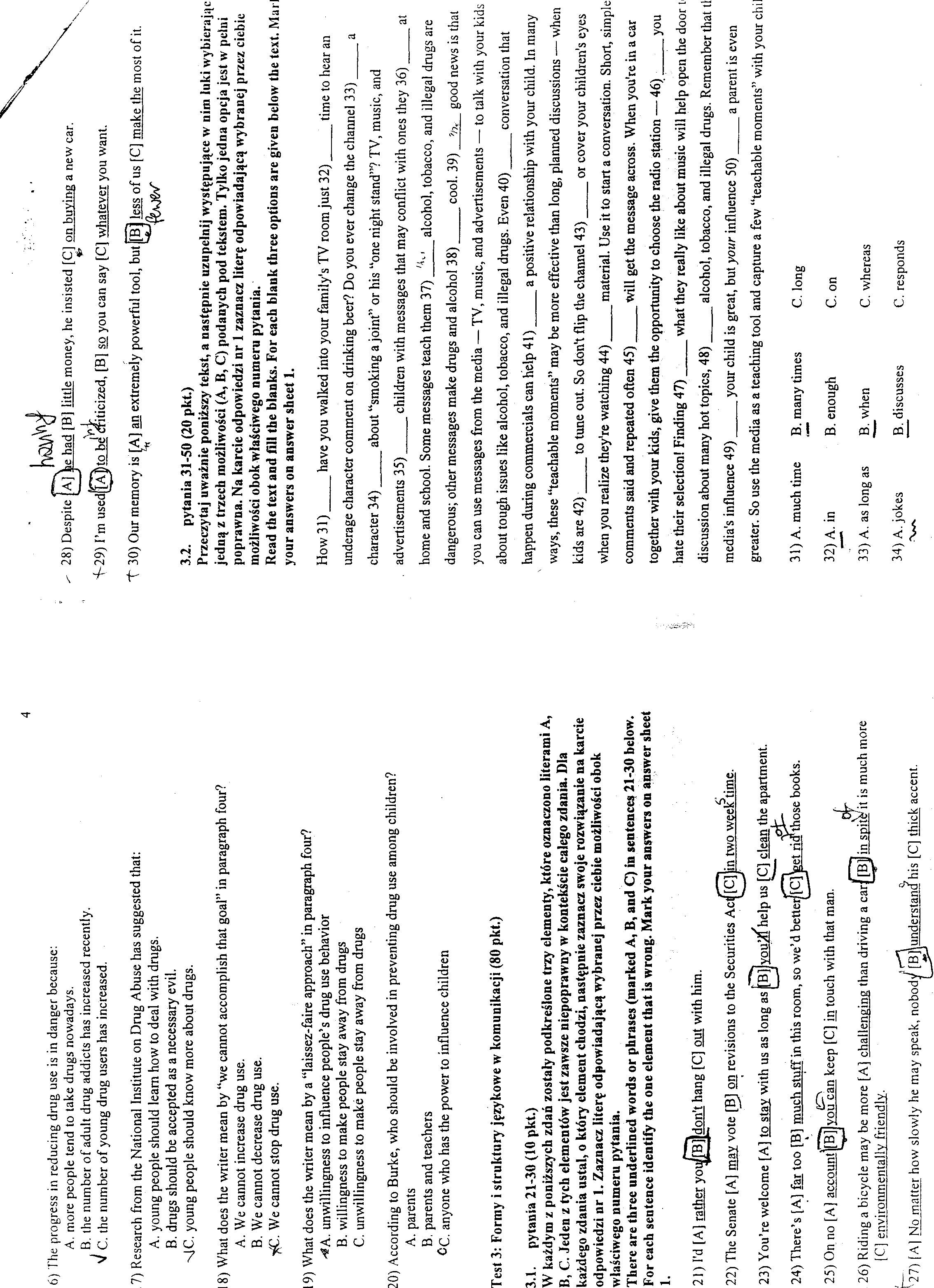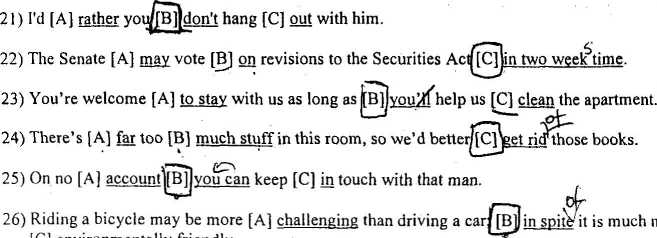42053 img098 2

4
6) The progress in reducing drug use is in danger because:
A, morę people tend to take drugs nowadays.
B. the number of adult drug addicts has increased recently.
V C. the number of young drug users has increased.
7) Research from the National Institute on Drug Abuse has suggested that:
A. young people should leam how to deal with drugs.
B. drugs should be accepted as a necessary evil.
-40. young people should know morę about drugs.
18) What does the writer mean by “we cannot accomplish that goal” in paragraph four?
A. We cannot increase drug use.
B. We cannot decrease drug use.
TfC. We cannot stop drug use.
19) What does the writer mean by a “laissez-faire approach” in paragraph four?
A. unwillingness to influence people’s drug use behavior
B. willingness to make people stay away from drugs
C. unwillingness to make people stay away from drugs
20) According to Burkę, who should be involved in preventing drug use among children?
A. parents
B, parents and teachers
CC. anyone who has the power to influence children
Test 3: Formy i struktury językowe w komunikacji (80 pkt.)
3.1. pytania 21-30 (10 pkt.)
W każdym z poniższych zdań zostały podkreślone trzy elementy, które oznaczono literami A, II, C. Jeden z tych elementów jest zawsze niepoprawny w kontekście całego zdania. Dla każdego zdania ustal, o który element chodzi, następnie zaznacz swoje rozwiązanie na karcie odpowiedzi nr 1. Zaznacz literę odpowiadającą wybranej przez ciebie możliwości obok właściwego numeru pytania.
There are three underlined words or phrases (marked A, B, and C) in sentences 21-30 below. For each sentence identify the one element that is wrong. Mark your answers on answer sheet 1.

1<- j envirumncmanv inenuiy.
27) [Aj No matter how slowly he may speak, nobod understancfhis [C] thick accent.
it is much morę

^ 28) Despite |A] be had [B] iittle money, he insisted [C] on buying a new car. Ą~29) l’m usedjfA^to bel ćjiticized, [B] so you can say [C] whatever you want.
30) Our memory is [A] an extremely powerful tool, but pi] less of us [C] make the most of it.
3.2. pytania 31-50 (20 pkt.)
Przeczyta j uważnie poniższy tekst, a następnie uzupełnij występujące w nim luki wybierając jedną z trzech możliwości (A, B, C) podanych pod tekstem. Tylko jedna opcja jest w pełni poprawna. Na karcie odpowiedzi nr 1 zaznacz literę odpowiadającą wybranej przez ciebie możliwości obok właściwego numeru pytania.
Read the text and fili the blanks. For each blank three options are given below the text. Mai l your answers on answer sheet 1.
How 31)_have you walked into your family's TV room just 32)_time to hear an
underage character comment on drinking beer? Do you ever change the channel 33)_a
character 34)_about “smoking a joint” or his “one nigbt stand”? TV, musie, and
advertisements 35)_children with messages that may conflict with ones they 36) ___ at
home and school. Some messages teach them 37) alcohol, tobacco, and illegal drugs are dangerous; other messages make drugs and alcohol 38) _____ cooi. 39) ''/% good news is that
you can use messages from the media — TV, musie, and advertisements — to talk with your kids
about tough issues like alcohol, tobacco, and illegal drugs. Even 40) ___conversation that
happen during commercials can help 41)_a positive relationship with your child. In many
ways, these “teachable moments” may be morę effective than long, planned discussions — when
kids are 42)_to tune out. So don't flip the channel 43)_or cover your chiidren‘s eyes
when you reałize they're watching 44)_materiał. Use it to start a conversation. Short, simple
comments said and repeated often 45)_will get the message across. When you're in a car
together with your kids, give them the opportunity to choose the radio station — 46)_you
hate their selection! Finding 47)_what they really like about musie will help open the door t
discussion about many hot topics, 48)__ alcohol, tobacco, and illegal drugs. Remember that ti
media's influence 49)_your child is great, but your influence 50)__a parent is even
greater. So use the media as a teaching tool and capture a few “teachable moments” with your chii
31) A. much time
32) A. in
33) A. as long as
34) A.jokes
B. many times B. enough B. when
B. discusses
C. long C. on
C. whereas
C. responds
Wyszukiwarka
Podobne podstrony:
24,25 I HormonesReplace the words in brackets with a morę medical term. Choose from the following.ac
PROGRESS IN THE SYNTHESIS AND USE OF ORGANIC PHOSPHORUS COMPOUNDS Katarzyna SzwaczkoLIGANDS DERIVED
f4 12 Create Foreign Key ZTXLFA1 -REGIO Short text Use the ualues in ztxlfa1cc to ualidate landl
img166 (3) 22 22 CN: Use a light blue for D, black for F, and gray for H. (1) Do n
CONTENTS L. Starkel: Progress in research on the evolution of the geographical environment of Poland
Czym jest religiologia? 49 Tyloch W. (ed.), Current Progress in the Methodology of the Science of Re
skanuj0054(1) ^ Complete the texts with the correct forms of the verbs in brackets. Use the present
skanuj0062(1) g Answer the questions. Use the verbs in brackets. Odpowiedz na pytania. Użyj czasowni
New?ventures Pre Itermediate Teacher s Book testy Test 4 A Vocabulary 1 Complete t
guy0001 Write the correct form of the verb in brackets to complete the sentences. Use one of these&n
htdctmw 075 Keep these drawings which depict the skuli in different angles, and use them as guides f
IMGx52 2 76 The Origin of Ciirflisation The progress of the Total Culture System,
więcej podobnych podstron